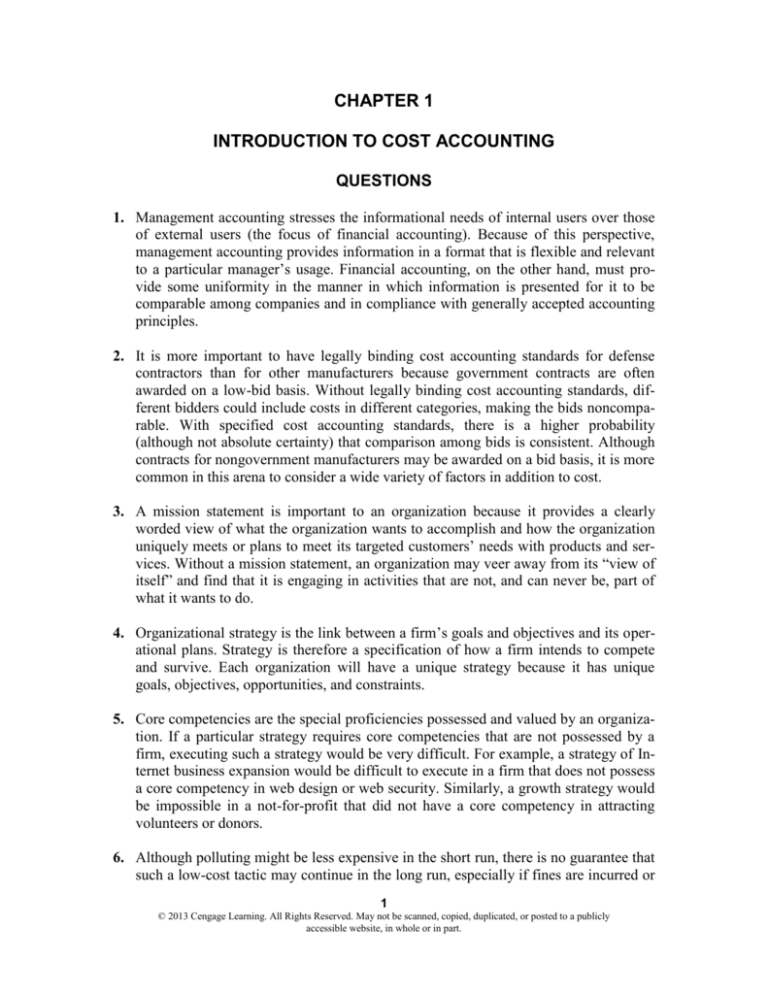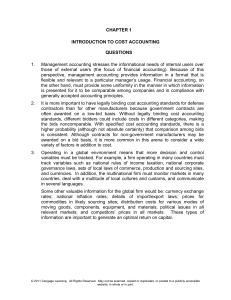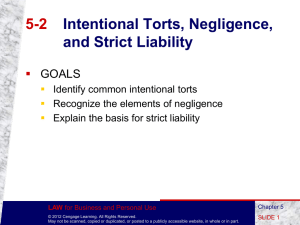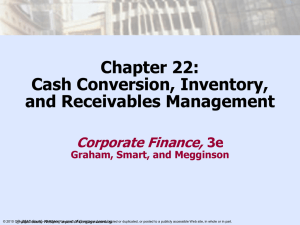
CHAPTER 1
INTRODUCTION TO COST ACCOUNTING
QUESTIONS
1. Management accounting stresses the informational needs of internal users over those
of external users (the focus of financial accounting). Because of this perspective,
management accounting provides information in a format that is flexible and relevant
to a particular manager’s usage. Financial accounting, on the other hand, must provide some uniformity in the manner in which information is presented for it to be
comparable among companies and in compliance with generally accepted accounting
principles.
2. It is more important to have legally binding cost accounting standards for defense
contractors than for other manufacturers because government contracts are often
awarded on a low-bid basis. Without legally binding cost accounting standards, different bidders could include costs in different categories, making the bids noncomparable. With specified cost accounting standards, there is a higher probability
(although not absolute certainty) that comparison among bids is consistent. Although
contracts for nongovernment manufacturers may be awarded on a bid basis, it is more
common in this arena to consider a wide variety of factors in addition to cost.
3. A mission statement is important to an organization because it provides a clearly
worded view of what the organization wants to accomplish and how the organization
uniquely meets or plans to meet its targeted customers’ needs with products and services. Without a mission statement, an organization may veer away from its “view of
itself” and find that it is engaging in activities that are not, and can never be, part of
what it wants to do.
4. Organizational strategy is the link between a firm’s goals and objectives and its operational plans. Strategy is therefore a specification of how a firm intends to compete
and survive. Each organization will have a unique strategy because it has unique
goals, objectives, opportunities, and constraints.
5. Core competencies are the special proficiencies possessed and valued by an organization. If a particular strategy requires core competencies that are not possessed by a
firm, executing such a strategy would be very difficult. For example, a strategy of Internet business expansion would be difficult to execute in a firm that does not possess
a core competency in web design or web security. Similarly, a growth strategy would
be impossible in a not-for-profit that did not have a core competency in attracting
volunteers or donors.
6. Although polluting might be less expensive in the short run, there is no guarantee that
such a low-cost tactic may continue in the long run, especially if fines are incurred or
1
© 2013 Cengage Learning. All Rights Reserved. May not be scanned, copied, duplicated, or posted to a publicly
accessible website, in whole or in part.
2
Chapter 1
additional legal regulations are enacted that would require retroactive cleanup. Being
green may be viewed from a self-serving standpoint: a proactive green strategy may
attract environmentally conscious consumers and provide a positive organizational
image (which could help attract labor talent). Further, such an approach may actually
be less expensive through reduced energy and waste costs. Current research indicates
that being green can be profitable to a business. Consumers may, in fact, be willing to
pay a bit more for products that are nondamaging to the environment and could cause
an organization to refocus on a product differentiation strategy that might be more
profitable than a low-cost strategy.
7. Authority is the right, generally because of position or rank, to use resources to accomplish a task or achieve an objective. Responsibility is the obligation to accomplish
a task or achieve an objective. Authority can be delegated, but responsibility must be
assumed and maintained by the person to whom it is assigned. However, sufficient
authority must accompany responsibility or the assignment of responsibility cannot
endure.
8. This statement is false. All firms have capital constraints, although the constraints are
more binding for some firms than others. For any firm, as the amount of capital raised
through either stock or bond offerings increases, the perceived riskiness of the offerings also rises. The perceived risk rises because there is greater uncertainty associated
with the new investment relative to the firm’s existing investments. As the perceived
risk rises, the rate of return required by the investors also rises. At some point, the
rate of return required by the investors will exceed the return that the firm can generate with the new funds.
9. Workforce diversity may affect organizational culture because the work ethic of individual workers may be less homogeneous, communication may become more difficult, and observation of different religious holidays may create difficulties or new
patterns of absenteeism. As workforce diversity increases, organizational culture must
change to reflect this diversity.
Some potential benefits of workforce diversity include an opportunity to reduce prejudices, having workers who prefer different holiday schedules (minimizing the need
for closure for specific holidays), and having workers who have different workplace
characteristics (for example, some cultures may prefer to work in groups; others
alone). Some potential difficulties of workforce diversity include the possibility of
different work ethics (for example, some cultures may perform at different “speeds,”
desire different workplace “formats” such as afternoon siestas, or view communication within the workplace about outside activities differently). There may also be less
tolerance if one employee group demands a greater number of religious holidays than
another or lacks understanding of why a particular employee (or employee group)
does not believe in the need for a specific holiday that the majority observes.
10. A change in laws or regulations may remove a constraint to competition or to a particular strategy. For example, the cost of labor has traditionally been much lower in
Mexico than elsewhere in North America. However, tariffs and taxes have historical© 2013 Cengage Learning. All Rights Reserved. May not be scanned, copied, duplicated, or posted to a publicly
accessible website, in whole or in part.
Chapter 1
3
ly constrained the extent to which American and Canadian businesses could exploit
that labor cost advantage. With the implementation of NAFTA, these costs have been
dramatically reduced. Consequently, American and Canadian businesses moved some
labor-intensive businesses to Mexico rather than to parts of Asia.
11. An organization’s value chain is the set of processes that converts inputs into products and services for the firm’s customers. The value chain includes both internal and
supplier processes, and captures the structure of activities by which an organization
competes. The value chain and strategy interface because optimizing value is the objective when managers strategize relative to the structure of the value chain.
12. The balanced scorecard is a framework that restates an organization’s strategy into
clear and objective performance measures. The balanced scorecard is used to evaluate
performance from four perspectives: learning and growth, internal business, customer values, and financial. These perspectives include financial, quantitative,
qualitative, lead and lag indicators, and short- and long-run measures. Managers
choosing to apply the balanced scorecard are demonstrating a belief that traditional financial performance measures, such as ROI, alone are insufficient to assess
how the firm is doing and what specific actions must be taken to improve performance. When organizations operate globally, it is less likely that a single measure of
performance (such as ROI) is sufficient to indicate success because of multiple goals
and objectives.
13. Operating in a global environment means that more decision and control variables
must be tracked. For example, a firm operating in many countries must track variables
such as national rules of income taxation, national corporate governance laws, sets of
local laws of commerce (including those for labor and the environment), production
and sourcing sites, and currencies. In addition, the multinational firm must monitor
markets in many countries, deal with a multitude of local cultures and customs, and be
aware of communication differences among languages. For example, product names
may not “translate” equally well into different languages. In the pharmaceutical industry, nuances in product names may mean the difference between life and death: the
FDA indicated that approximately 13 percent of medication errors arise from communication errors and another 13 percent from name confusion (http://www.brandchannel
.com/features_effect.asp?pf_id=243).
Some other valuable information for the global firm would be currency exchange
rates; national inflation rates; details of import/export laws; prices for commod ities in likely sourcing sites; distribution costs for various modes of moving goods,
components, equipment, and materials; political issues in all relevant markets; and
competitors’ prices in all markets. These types of information are important to
generating an optimal return on capital.
14. The purpose of this question is to get students to think about the role of laws and ethics in conducting business. Among the important points that should be made in the
position papers include whether the laws in the firm’s home country or local foreign
law should govern the actions of firms, whether ethics or law should be the standard
© 2013 Cengage Learning. All Rights Reserved. May not be scanned, copied, duplicated, or posted to a publicly
accessible website, in whole or in part.
4
Chapter 1
governing actions in foreign jurisdictions, and the extent to which “being competitive” should be a criterion in choosing a business course of actions. Venezuela was
selected because it has not signed the OECD Anti-Bribery Convention; it has also
been rated as 172 out of 183 economies for overall “ease of doing business”
(http://www.doingbusiness.org/data/exploreeconomies/venezuela). There have been
currency devaluations, power and water rationing, nationalization of organizations,
and a high level of political instability. All of these issues could result in ethical issues for a U.S. company.
© 2013 Cengage Learning. All Rights Reserved. May not be scanned, copied, duplicated, or posted to a publicly
accessible website, in whole or in part.
Chapter 1
5
EXERCISES
15. a. The bank would want information about the firm’s ability to repay the loan. Potentially, the loan could be repaid from either of two sources: (1) by liquidating assets
that are not crucial to business operations or (2) from future operating cash flows.
Consequently, the most useful items of information would be a balance sheet, income statement, statement of cash flows, and perhaps a cash budget. The balance
sheet provides information about the types of assets owned by the firm and the
cash commitments for debt repayments and payments to suppliers. The income
statement is useful for assessing profitability and projecting future cash flows. The
statement of cash flows and the cash budget provide information about the sources
and uses of cash.
Information about accounts receivable turnover, or the average time to collect accounts receivable, can be determined by examining the history of accounts receivable collections. How readily accounts receivable can be collected can be assessed
by determining the extent to which the accounts receivable are past due.
A trend for supplier price and labor cost increases can be assessed by examining
purchases and salaries over time. Reading Journal of Accountancy and Strategic
Finance will provide information about salary trends. Prices of specific, routine
inputs can be obtained from supplier invoices and purchase order data.
Qualitative information that would interest the bank might include the character of
the partners, their history in handling borrowed funds, management skills in the
firm, stability of business conditions, work backlog, financial strength of largevolume customers, and supplier willingness to provide favorable credit terms on
purchases.
b. An example of accumulating the information to address customers’ complaints regarding delays in completing financial planning and tax jobs can be found on the
customer order documents. The customer order document should be designed to
capture the promised time of completion of the job and also to capture the actual
completion time. The time variance can be accumulated systematically on a log or,
alternatively, can be determined by inspection of the customer order documents. In
this way, these documents, that comprise part of the accounting system, can be
used to track such nonfinancial data.
Price changes are usually justified on the basis of one or more of the following: (1)
competitor price changes; (2) willingness by customers to pay higher prices on the
basis of quality or other types of differentiation of products and services; (3) governmental regulations or requirements; and (4) changes in the prices of material,
labor, or other costs such as utilities, taxes, and insurance. Information regarding
the first three justifications must usually be obtained from sources outside the accounting system. However, changes of prices and therefore costs of the factors of
production described in justification (4) can be found from accounting records and
documents.
© 2013 Cengage Learning. All Rights Reserved. May not be scanned, copied, duplicated, or posted to a publicly
accessible website, in whole or in part.
6
Chapter 1
For example, by examining labor time and costs over time, one can assess trends in
time to complete specific types of jobs and labor cost increases. Labor cost data
may be obtained by examining personnel and payroll records of partners, managers, and staff accountants. Analysis of labor costs may indicate that staff accountants could be used in place of partners to significantly reduce costs on some jobs.
Prices of specific, routine inputs can be obtained from supplier invoices and purchase order data. Examining and comparing invoices and tax reports may indicate
a trend in utilities, insurance, and tax costs over time.
c. Most of the data can be gathered directly from the accounting records or from the
documents that support the accounting records such as original transaction documents (invoices, payroll time cards, shipping records, etc.). However, none of the
qualitative data could be obtained from the accounting records. The bank would
have to acquire this information from other sources such as character references,
suppliers, and customers.
16. a. Each student will have a different answer; however, the following items may be
mentioned:
Then
“Number cruncher”
Staff member with limited
responsibilities
Controller of costs
Provider of internal reports
Impediment to change
Provider of data
Work in relative isolation
Accountant
Reactive
Now
Decision support specialist
“Business partner”
Analyst of costs
Developer of models
Implementer of change
Provider of information
Member of cross-functional
teams
Member of the finance function
Proactive
b. Each student will have a different answer; however, the following items may be
mentioned: interpersonal skills, communication skills, technological skills, critical
thinking and analysis skills, planning and decision-making skills, broad-based
learning, performance measurement and evaluation skills, and knowledge of the
international marketplace. One source (http://www.careers-in-accounting.com
/acskill.htm) indicates the following as necessary skills for management accountants:
© 2013 Cengage Learning. All Rights Reserved. May not be scanned, copied, duplicated, or posted to a publicly
accessible website, in whole or in part.
Chapter 1
People skills
Sales skills
Communication skills
Analytical skills
Ability to synthesize
Creative ability
Initiative
Computer skills
7
Medium
Low
High
High
High
Medium
Medium
Very high
The primary change in the past 10 years has been in the area of technology and,
given that, computer skills have emerged as an exceptionally important new part of
the skill set of management accountants.
17. Each student will have a different answer. No solution is provided.
18. Each student will have a different answer. No solution is provided.
19. Each student will have a different answer. No solution is provided.
20. a. A mission statement adds strength to an organization’s strategic planning process
by providing a clear view of what the organization wants to accomplish and how it
uniquely meets customers’ needs with products and services. Without a mission
statement, an organization may find that it is engaging in activities that are not, or
never can be, part of what it wants to do or is able to do.
b. A mission statement should be developed using input from everyone involved in
the value chain within the organization. Such an inclusionary process will help ensure that the statement will become internalized by organizational members and
become part of the organizational culture.
c. In developing a mission statement, organization members need to consider the organization’s strengths (including core competencies) and weaknesses, opportunities for growth, customer base (current and desired), competition, constraints
(physical, financial, technological, etc.), profitability, and employees’ skills (current and those that can be acquired through training or hiring).
d. Each student will have a different answer. No solution is provided.
21. a. Not every organization needs a mission statement. However, having one aids the
organization by providing a clear statement of what the organization wants to accomplish and how it uniquely meets customers’ needs. Without a mission statement, an organization may find that it is engaging in activities that are not part of
what it wants to do or is able to do well.
b. A mission statement can help an organization encourage ethical behavior by establishing ethical values as an organizational characteristic. By promoting ethical behavior in the mission statement, the organization is reinforcing ethical behavior as
a distinct and critical part of the organizational culture.
© 2013 Cengage Learning. All Rights Reserved. May not be scanned, copied, duplicated, or posted to a publicly
accessible website, in whole or in part.
8
Chapter 1
c. A mission statement can help an organization strive for a higher level of product
quality and customer service in much the same way that it helps promote ethics in
the organization—it reinforces these concepts as part of organizational culture and,
thus, “demands” the organization to aspire to continual improvement.
22. Each student will have a different answer. No solution is provided.
23. a. You might want to have information on the average age of your primary customers, their food preferences, what your competitors offer (quality and price), and the
skills of your cook.
b. The average age of your customer is important because quiche would probably be
more favorably received by younger customers, and rack of lamb would probably
be preferred by more affluent customers. Competitors’ offerings would indicate
whether you would be able to compete on quality and price, assuming the selections you choose were currently available at your competitors’ restaurants (product
differentiation). Your cook’s talent is crucial because, regardless of preference or
need, if the cook is unable to prepare the dish properly, customers will not purchase it.
24. Each student will have a different answer. No solution is provided.
25. a. Each student will have a different answer, but the following items may be mentioned:
(1) Fiscal, legal/regulatory, and political
(2) Fiscal and regulatory (i.e., disposal of cartridges)
(3) Fiscal and legal/regulatory
(4) Cultural, fiscal, legal/regulatory, and political
b. (1)
(2)
(3)
(4)
Fiscal: most cities are in some type of economic downturn
Fiscal: small businesses usually have budgetary constraints
Legal/regulatory: possible unfamiliarity with the legal system
Legal/regulatory: laws of multiple countries must be understood and obeyed
26. Each student will have a different answer. No solution is provided.
27. Each student will have a different answer. No solution is provided.
28. Each student will have a different answer, but the following items may be mentioned:
a. Employees might be empowered to decide which clients they will advise, how
often these clients need to be contacted, what activities need to be performed to
provide high-quality financial planning, and what resources are needed to provide these services. Employees are in a much better position to judge these i ssues than an absentee owner.
© 2013 Cengage Learning. All Rights Reserved. May not be scanned, copied, duplicated, or posted to a publicly
accessible website, in whole or in part.
Chapter 1
9
b. As the owner, you may retain the billing process as well as the marketing function.
You would also probably want to verify customer satisfaction through surveys or
telephone calls. These matters will be essential to your business profitability and
longevity, and the employees may not have the expertise or ability to handle these
matters.
29. Each student will have a different answer. However, the following items may be mentioned:
a. The upstream value chain would include shareholders/bondholders, raw materials
suppliers, transportation companies, equipment manufacturers, and so forth.
b. Internal activities would include purchasing, receiving, package design, manufacturing, and so forth.
c. The downstream value chain would include distributors, transportation companies,
market research, advertising firms, customers, and so forth.
30. a. A strategic alliance would be considered illegal in the United States when it interferes with free trade such as colluding with other organizations to fix prices.
b. Each student will have a different answer, but the following partners may be mentioned: establishment of a consistent supply chain (both in quantity and quality), a
strong customer base, integration of activity (such as airline, hotel, and car rental
alliances), and so forth.
c. Each student will have a different answer, but the following partners may be mentioned:
Catalog production company
Photographer
Wholesale plant distributor
Flower pot manufacturer/designer
Floral arranger
Transportation company
31. a. A balanced scorecard is used to:
clarify or update a business’s strategy,
link strategic objectives to long-term targets and annual budgets,
track the key elements of the business strategy,
incorporate strategic objectives into resource allocation processes,
facilitate organizational change,
compare performance of geographically diverse business units, and
increase companywide understanding of the corporate vision and strategy.
b. The majority of value in many modern businesses rests in the intangible assets (often times people and their organizational knowledge). Also, modern companies
recognize that mission success (or competitiveness) is primarily driven by the ide© 2013 Cengage Learning. All Rights Reserved. May not be scanned, copied, duplicated, or posted to a publicly
accessible website, in whole or in part.
10
Chapter 1
as and innovations that come from people. Older management practices that are
focused solely on financial metrics and production activities are not appropriate in
this new environment. Financial metrics are lagging indicators that tell what happened in the past. Knowledge workers communicate and create in complex ways.
Managers need a new way to assess how well their organization is functioning,
how to predict future performance, and how to align the organization toward new
strategies to achieve breakthrough performance.
The balanced scorecard has evolved to support strategic planning and management
in this new work environment. The BSC changes the strategic plan from passive
document into organizational “marching orders.” It provides a framework that provides performance measurements and helps planners identify what should be
measured. It enables executives to truly execute their strategies.
c. There are always challenges associated with any innovative management idea or
any effort that seeks to change the status quo in a large organization. A comprehensive BSC is somewhat difficult and time consuming to implement, and sustained top-level support and commitment to develop and implement the system is
required. If the organization does not have a high-ranking champion, does not have
adequate funding, and is not ready to change, the BSC will be unsuccessful.
32. a. The IMA guidelines focus on competence, confidentially, integrity, and credibility.
Competence means that individuals will develop and maintain the skills needed to
practice their profession including ongoing professional education. Confidentiality
means that the cost accountant will refrain from disclosing company information to
inappropriate parties or using such information to generate an illegal or unethical
advantage. Integrity means that individuals will not participate in activities that
would discredit the profession or violate the company’s corporate governance policies. Credibility means that the cost accountant will provide full, fair, and timely
disclosure of all relevant information that may affect a user’s decision.
b. The cost or management accountant should document which regulation is believed
to have been violated and then research and record the appropriate actions that
should have been taken. Document the research findings as evidence of violations
found. This information should be kept confidential and reported and discussed
with a superior who is not involved in the action. If the immediate superior is involved, then it may be necessary to communicate with someone higher up the corporate ladder (possibly up to the audit committee). Again, it is important to
document each communication and finding throughout the process. If the management accountant cannot resolve the matter, then he or she should resign. The
management accountant should consult legal counsel before reporting the matter to
regulatory authorities.
33. Each student will have a different answer. No solution is provided; however, it is essential that students realize that computer software piracy is an illegal as well as unethical activity. Piracy of any intellectual property is theft.
© 2013 Cengage Learning. All Rights Reserved. May not be scanned, copied, duplicated, or posted to a publicly
accessible website, in whole or in part.
Chapter 1
11
34. a. Such a law change would reduce costs in the short run. All of the costs of complying with current environmental laws and policies would be eliminated. However,
in the long term, it could be argued that costs would rise well above current levels.
Higher costs would be reflected in health care; permanent environmental damage
to recreational lands, fisheries, and agricultural land; and contamination of surface
waters and aquifers. The consequences of this pollution would be dire in the long
run and would include the social costs of loss of life and loss of health. There
could also be backlash from the environmentally concerned sector of the consumers of the output of U.S. production.
b. Each student will have a different answer as it would depend upon how important
he/she believes environmental laws are for businesses. No solution is provided.
c. Each student will have a different answer as it would depend upon how important
he/she believes environmental laws are for businesses. However, it is likely that
most students would indicate there would be more negative reaction from industrialized nations than from developing countries. No solution is provided.
35. The purpose of this question is to get students to think about the role of laws and ethics in the conduct of business. Among the important points that should be made in the
position papers include whether the laws in the firm’s home country or local foreign
law should govern the actions of the firm, whether ethics or law should be the standard governing the actions in foreign jurisdictions, and the extent to which “being
competitive” should be a criterion in choosing a business course of action.
36. a. If an organization’s management accountant is, in fact, primarily dealing with internal accounting and finance matters, then it is more likely that the financial accountant would be more involved in earnings management situations.
b. Each student will have a different answer. Some earnings management falls under
the heading of normal business decision making, while “abusive” earnings management is viewed as intentional and material manipulation. Past-SEC Chairman
Arthur Levitt criticized accounting tactics such as improper revenue recognition,
unjustified restructuring charges, and “cookie-jar reserves.” Accountants know all
of these (and more) as “accounting irregularities”—intentional misstatements in financial reports, which should often be regarded as the equivalent of fraud. Fraud
is, of course, illegal and unethical. As Warren Buffett once said, “Managers who
always promise to ‘make the numbers’ will at some point be tempted to ‘make up’
the numbers.”
37. a. The CEO would be concerned about the earnings management if it were to be considered “abusive.” Under the 2002 Sarbanes-Oxley Act, an organization’s CEO
and CFO are personally accountable for the accuracy of their company’s financial
reporting.
b. Yes, whistle-blowing managers in SEC-registered companies are protected from
retaliation under Section 806 of the Sarbanes-Oxley Act. Covered disclosures in© 2013 Cengage Learning. All Rights Reserved. May not be scanned, copied, duplicated, or posted to a publicly
accessible website, in whole or in part.
12
Chapter 1
clude providing information or assistance in the investigation of conduct believed
to be a violation of securities laws or regulations. This section of SOX relates to
providing information or assistance to law enforcement, congressional members or
committees, and internal organization members with supervisory or investigative
authority.
38. a. The quote indicates that the predominant concern of American businesses should
be profit generation. There is nothing explicit or implied in the statement to indicate that profits must be derived from that set of activities that is legal within the
local jurisdiction. Given that the pursuit of profit is constrained to legal activities,
Friedman’s statement is merely a pro-capitalism one.
b. Ethically, one might feel that the pursuit of profit should be constrained such that
profit is not pursued to the detriment of human life, human happiness, the environment, etc. In short, ethically, one might easily identify several objectives that
managers should hold in preference to maximization of profits.
c. Taking a long-term view, it might be logical to argue that managers’ profitmaximizing actions are those actions that are both legal and ethical. In the long
run, illegal actions draw fines, lawsuits, new regulations, and other costly sanctions; unethical acts tarnish business reputation and lose customers and market
share. Hence, in the long run, there may be no conflict between Friedman’s statement as to managers’ obligations and the legal and ethical obligations of managers.
39. In addition to domestic exchanges, Volkswagen AG lists on the Frankfurt, Basel, Geneva, Zurich, Luxembourg, London, and New York stock exchanges. When listing on
multiple stock exchanges, the multinational must know and comply with the corporate governance rules of each stock exchange. What is permitted on one stock exchange may be illegal on another. For example, the Sarbanes-Oxley Act requires a
CEO to sign off on the accuracy of financial reports, but this is not required in Japan
or London. SOX also requires that a majority of the members of corporate boards of
directors be independent from the company; such a requirement does not exist in Japan.
© 2013 Cengage Learning. All Rights Reserved. May not be scanned, copied, duplicated, or posted to a publicly
accessible website, in whole or in part.












